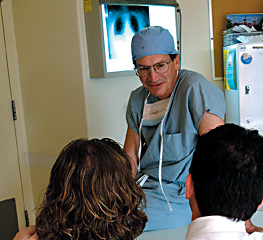 |
||
| uvm a - z | directory | search |
 |
DEPARTMENTS LINKS
|

Prepared For Disaster
Bill Cioffi '77, heads treatment
of Rhode Island fire victims
As smoke poured from The Station nightclub
in West Warwick, Rhode Island on February 20 in what would turn into
one the nation’s deadliest fires, Dr. William Cioffi was preparing
his staff for the onslaught of burn victims that would soon arrive.
It was a moment that the chief of surgery at Rhode Island Hospital had
been preparing for most of his life, really — first as a medical
student at UVM, M.D.’85, and later as a surgeon in the U.S. Army
where he spent 11 years traveling the globe rescuing and treating badly
burned U.S. military personnel.
Cioffi, one of the nation’s pre-eminent burn specialists, was perhaps
the ideal man to have coordinating the disaster relief effort that cruel
winter night. Modest in nature, the UVM undergraduate and med school
alum will tell you that luck was involved in keeping alive all 64 burn
victims treated at the hospital that night — that the outcome may
have been different if patients hadn’t started arriving at midnight
during a shift change allowing for an optimally high number of personnel
to help.
It wasn’t luck, however, that Cioffi had been trying to turn Rhode
Island Hospital and the entire state into a nationwide model of an ideal
trauma system. Because of these pre-disaster efforts, Cioffi and his
staff had plenty of saline solution on hand to feed intravenously to
patients to prevent fluid loss, something that years ago commonly caused
kidney failure resulting in death.
“We took over the entire 5th floor,” says Cioffi, whose wife
Theresa Graves MD’85 is a general surgeon and played a critical
role in saving patients that night. “I asked if the hospital was
going to support me. They said ‘yes,’ and then let me do whatever
I wanted.”
Cioffi’s expertise in the areas of resuscitating patients in the
first 24 hours by supporting the lungs of victims with inhalation injury,
and the more recent advance of quickly removing any dead tissue and
getting skin grafted and wounds closed, proved critical. Cioffi was
praised for his mastery of these relatively recent advances by a number
of national media outlets including The New York Times and NBC’s
“Today Show,” where he was interviewed by host Matt Lauer.
“A lot of things worked out fortuitously,” Cioffi says. “But
I truly think if we hadn’t gone through that year of planning,
it would have been a different outcome. In reality, we could have cared
for another 40 patients that night. I was told we were going to get
100 people and we were prepared for that.”
Cioffi owes much of his seemingly tailor-made training for the nightclub
fire — fourth worst of its kind in U.S. history — to his time
spent as a surgeon in the Army. It wasn’t long after spending more
than a decade at UVM as an undergraduate ’77, med student, and
resident, that Cioffi joined the military and started flying around
the world in a helicopter rescuing burn victims. Among other missions,
he was part of the medical team called to Ramstein Air Force Base in
Germany for the air show crash there in 1988 that claimed the lives
of 70 people.
“I got my feet wet in burn disaster management in the Army,”
Cioffi says. “We were often in the air for 12-to-24 hours, so we
had to find ways to treat burn victims safely for long periods of time
right after being injured.”
Yet Cioffi had never dealt with a disaster of the magnitude of the Rhode
Island fire, which claimed the lives of 100 people and injured 200 more.
But his prior experience, coupled with the development of a Hospital
Emergency Incident Command System and an ongoing effort by Cioffi to
make Rhode Island a nationwide model for disaster response, made the
night of February 20 a case study in proper trauma systems management.
“I came here because it’s a small state and thought I could
make Rhode Island into the ideal trauma system,” Cioffi says. “After
years of not thinking that was going to happen, I now think it will
become a reality. Each state has different needs, so if we’re not
a model, our system will at least work very well for the people of the
state.”
—Jon Reidel
